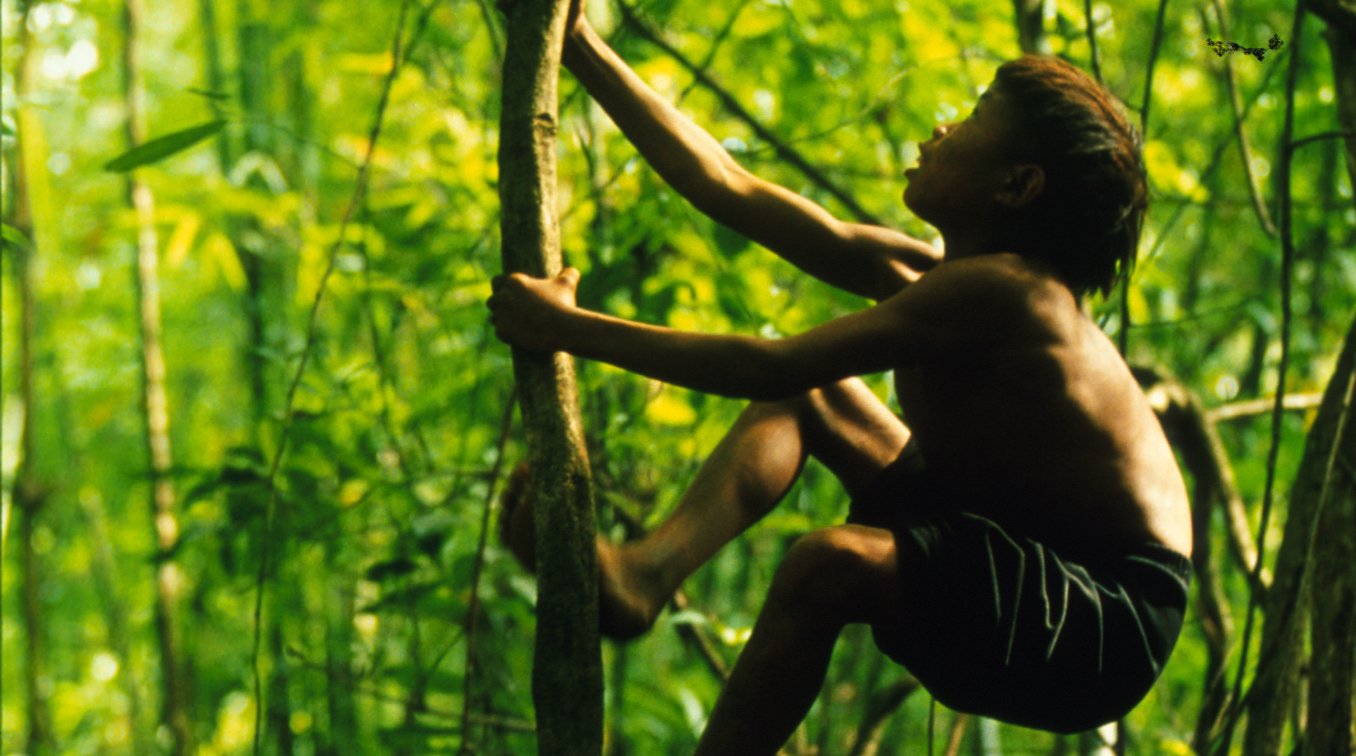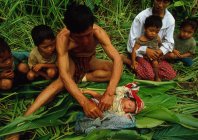
The Mlabris, people of the yellow leaves : twilight of a people.
Patrick Aventurier
Gamma
Today there are only 22 left in Laos and around a hundred in Thailand. The Mlabris are the last remaining hunter-gatherers of the forests on the Northern border of these two countries. They are an ethnic minority close to extinction, and ethnologists predict that they will only survive a further 10 or 20 years.
Preview


The “Phi Tong Luang”, the people of the yellow leaves, owe their name to the makeshift shelters which they build in the jungle using bamboo and banana leaves and which they leave as soon as the leaves turn yellow. These nomadic hunter-gatherers live in Laos (in Xayaburi province) and in Thailand (in Nan and Phrae provinces). They move every 5 to 15 days, within a perimeter of around 900 km_. They dig for roots and tubers, collect the honey of wild bees, gather berries, fruits, and flowers, hunt with spears, trap birds, or even catch crabs and shellfish in rivers. They can not live without the tropical forest. They have lived like this in total harmony with the jungle for hundreds, perhaps thousands of years. But the 20th century proved to be disastrous for the Mlabris.
For a few decades now, this particularly peaceable people has been helpless faced with the destruction of the forest which feeds them and which is shrinking away. Systematic deforestation and slash-and-burn cultivation have resulted in the disappearance of 80% of Thailand's forest. Having been the victims of military conflicts, having been forced from their natural habitat, and exploited by their sedentary neighbours, the number of Mlabris has continued to fall. A century ago, 180 Mlabris lived in Laos. In 1985, there were 67 and today only 22 are left: 6 men, 9 women and 7 children. In Thailand, they number around a hundred, half of whom have become more or less sedentary. The forest has been bled dry and can no longer sustain them and they now depend on the neighbouring populations to survive. In exchange for a little rice, a pig, some salt, clothes or blankets, the nomads sell their labour to the Hmong and the Thai. In a state of semi-slavery, they work in the fields and clear plots of land. It is a cruel paradox that in order not to starve, the Mlabris take part in the destruction of their own forest. The hills that were once covered in jungle have become agricultural land that is eroded by the rain and inevitably arid in the dry season.
Among the minorities in the world threatened with extinction, the Mlabris are sadly at the top of the list. One can read in their faces the despair of a people who is conscious of its fate and its extreme vulnerability. Some have chosen to continue to live their native way of life, until the darkness destroys them all. Others return to the forest for several days before coming back to wander, distraught and starving near the villages where they end up settling down. Mlabri-Hmong marriages take place. Mlabri children sit on the same benches as the Hmong and the Thai in the village schools. Within one or two generations, the young Mlabris will have totally forgotten life in the forest. Ethnologists predict that the "people of the forest" will probably have disappeared in ten to twenty years' time.
Support programmes
Laurent Chazée, a French ethnologist, is trying to protect the last 22 Mlabris living in Laos. With the support of ICRA (the International Commission for the Rights of Arboriginal Peoples), the Dutch Embassy in Bangkok and Vientiane International Consultants, he persuaded authorities in the province of Xaraburi to protect the last surviving members of the tribe. Laurent Chazée has set up a research, preservation, development and support programme, respecting this community's wish to remain independent and preserving its ancestral values. The programme provides the Mlabris with regular health checks which are carried out by a local doctor in the forest, emergency operations when there are accidents, and safety shelters equipped with clothes and blankets so that the weakest can have easy access to a refuge. Since May 2000, a new provincial resolution has recognised the cultural and territorial identity of the Mlabris.
In Thailand, there are no support programmes for the Mlabris which respect their culture. The governor of Nan province has had makeshift accommodation built for the Mlabris who work for the Hmongs, the children who live there being obliged to attend school. Some Thais take advantage of the people of the yellow leaves and use them as an attraction for tourists in search of authentic tribal folklore. In such cases the nomads are exhibited as "noble savages" in a human zoo. Even worse is the creation of the "Centre for the Conservation and Development of the People of the Yellow Leaves" by an American missionary from the powerful New Tribes Mission. This pompous name hides a quite different reality. The missionary wants to convert the Mlabris to Christianity and to integrate them into the rest of the Thai population, but most of all he wants to keep them working for him as long as possible.
This project was produced with the help of ICRA (International Commission for the Rights of Arboriginal Peoples).


